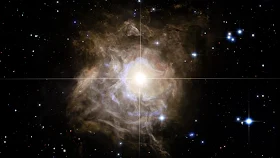Το επιβλητικό RS
Puppis. This episode of the Hubblecast explores striking new Hubble
observations of a variable star known as RS Puppis. This star is growing
brighter and dimmer as it pulsates over a period of five weeks. These
pulsations have created a stunning example of a phenomenon known as a light
echo, where light appears to reverberate through the foggy environment around
the star. Image credit: NASA, ESA, and the Hubble Heritage Team
(STScI/AURA)-Hubble/Europe Collaboration. Acknowledgment: H. Bond (STScI and
Penn State University)
Βλέποντάς
το κάποιος θα έλεγε με ευκολία ότι πρόκειται για το άστρο που οδήγησε τους
τρεις μάγους στη Βηθλεέμ.
This artist's
impression shows the location of the Cepheid star RS Pup in our Galaxy. From
ESO NTT observations of the echoes on several nebular features, the distance of
RS Pup was found to be 6500 light-years, with an uncertainty of 90 light-years.
RS Pup is distant by about a quarter of the distance between the Sun and the
Centre of the Milky Way. RS Pup is located within the Galactic plane, in a very
populated region of our Galaxy. Copyright: ESA/Hubble & ESO
Πρόκειται
για το RS Puppis που βρίσκεται σε απόσταση 6,5 χιλιάδων ετών φωτός από τη Γη το
οποίο φωτογράφισε σε όλη του την μεγαλειότητα το διαστημικό τηλεσκόπιο Hubble.
This image from the
Digitized Sky Survey shows variable star RS Puppis and its surroundings. This
field is rich in intriguing astronomical objects. RS Pup is the bright star
right in the centre of the frame. It is a type of variable star known as a
Cepheid variable. As variable stars go, Cepheids have comparatively long
periods – RS Puppis, for example, varies in brightness by almost a factor of
five every 40 or so days. RS Puppis is unusual; this variable star is shrouded
by thick, dark clouds of dust enabling a phenomenon known as a light echo to be
shown with stunning clarity. Also visible towards the bottom centre of the
field is another variable star known as Y Puppis. Like RS Puppis, it too is a
pulsating star, although its period is a little less regular. It is part of a
multiple star system over 400 light-years away from us. This star is very
bright in the infrared, and is seen as a fiery red colour. Just to the right of
Y Puppis is another intriguing object known as V351 Puppis, or Nova Pup 1991,
shown as the rather distinctive yellow object. This star expelled its outer
layers into the surrounding space in 1991, forming nebulous shells of gas. Copyright:
ESA/Hubble, NASA & Digitized Sky Survey 2. Acknowledgement: Davide De
Martin
To
RS Puppis είναι 200 φορές πιο μεγάλο από τον Ήλιο και 15 χιλιάδες φορές πιο
λαμπρό!
This time-lapse
video uses observations from the NASA/ESA Hubble Space Telescope over a number
of weeks to show the variable star RS Puppis and its environment. A stunning
example of a phenomenon known as a light echo can be seen around the star,
creating the illusion of gas clouds expanding out from RS Puppis. Credit: NASA,
ESA, the Hubble Heritage Team (STScI/AURA)-ESA/Hubble Collaboration, and H.
Bond (STScI and Pennsylvania State University)
Το
RS Puppis ανήκει στους Κηφείδες, μια οικογένεια παλλόμενων μεταβλητών αστέρων. Χαρακτηρίζονται
από περιοδικές διακυμάνσεις στη φωτεινότητά τους λόγω περιοδικών μεταβολών των
διαστάσεων, της θερμοκρασίας ή κάποιας άλλης αστρικής ιδιότητας που οφείλεται σε
εσωτερικές διαδικασίες.



Δεν υπάρχουν σχόλια:
Δημοσίευση σχολίου